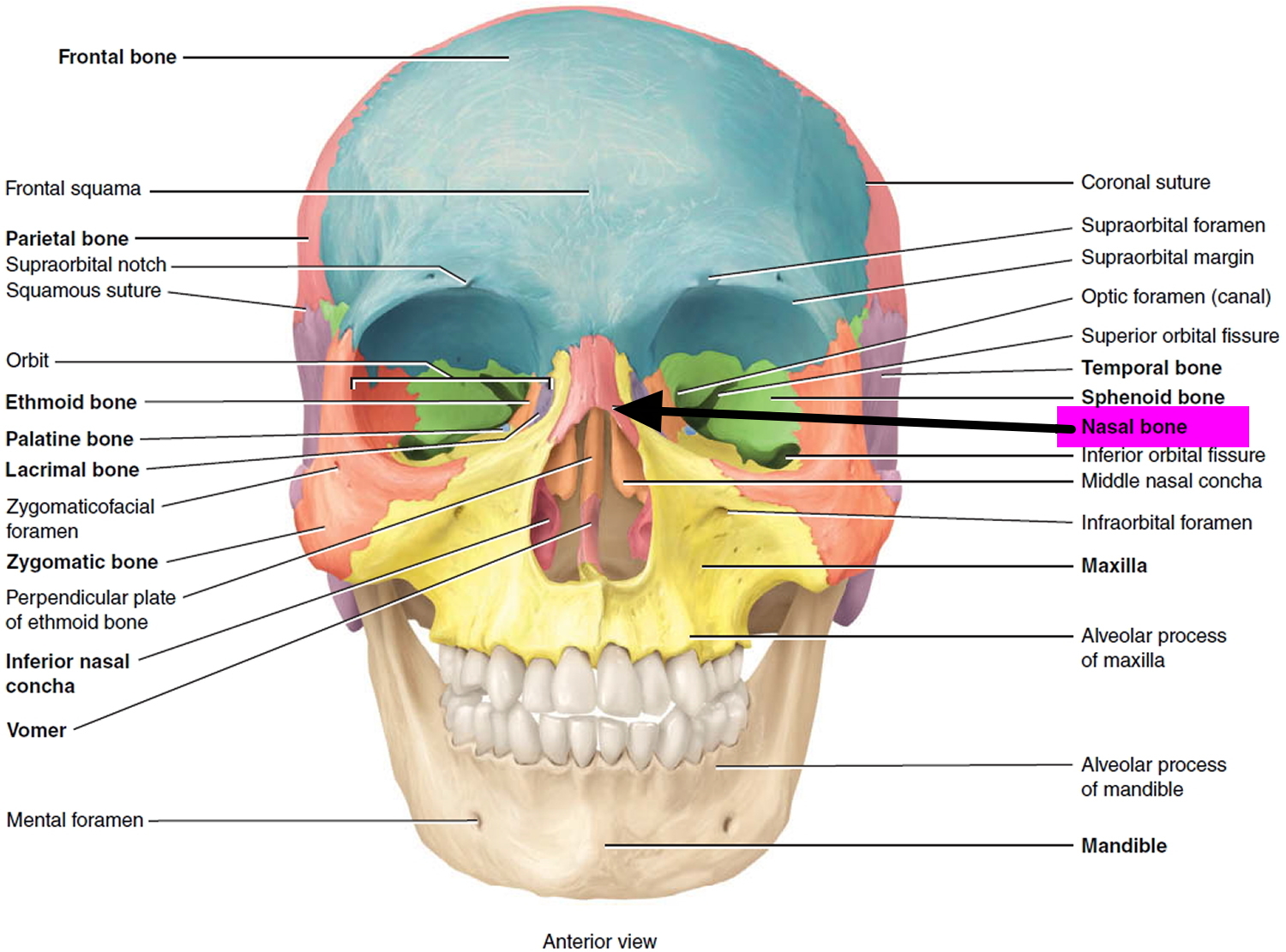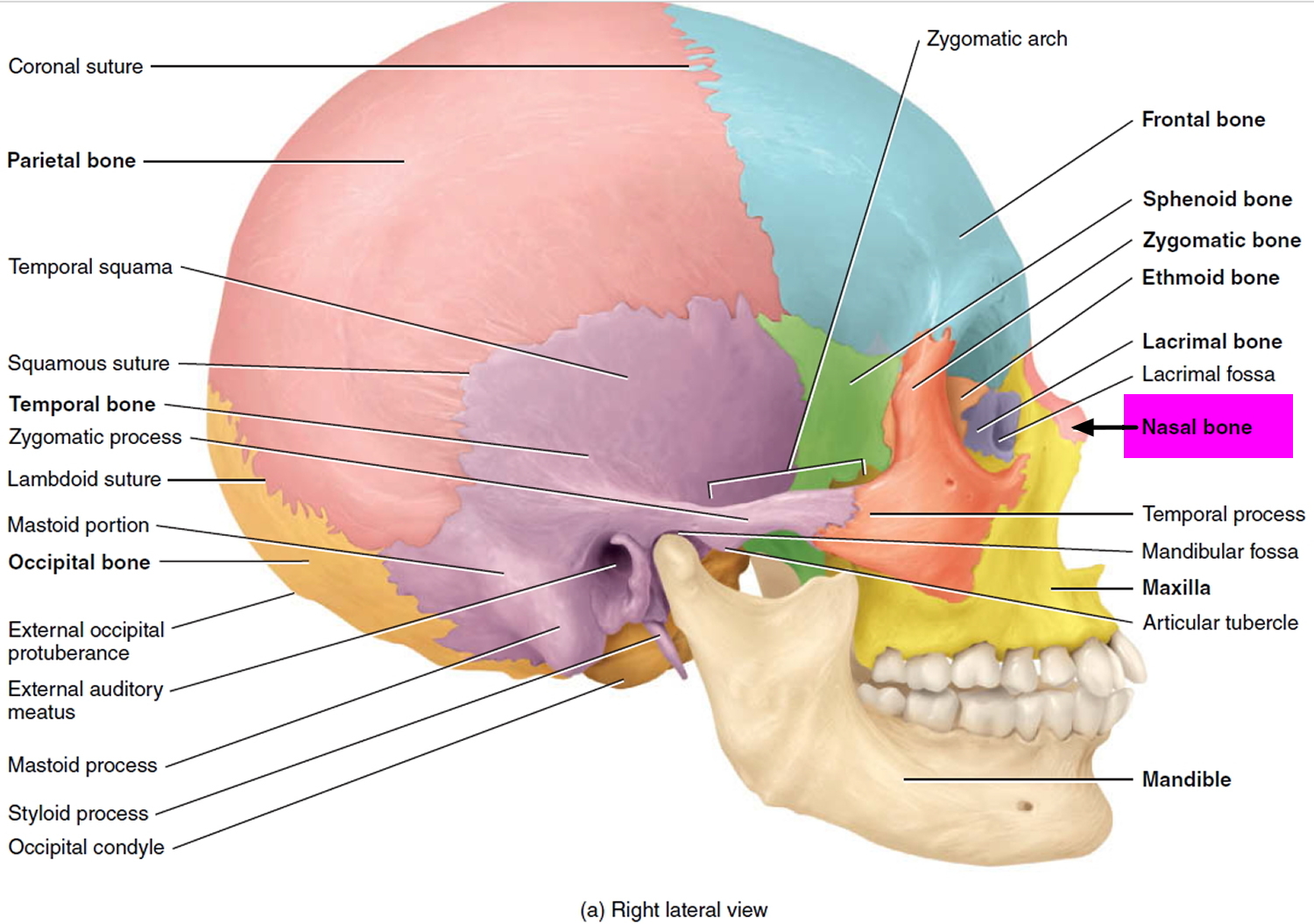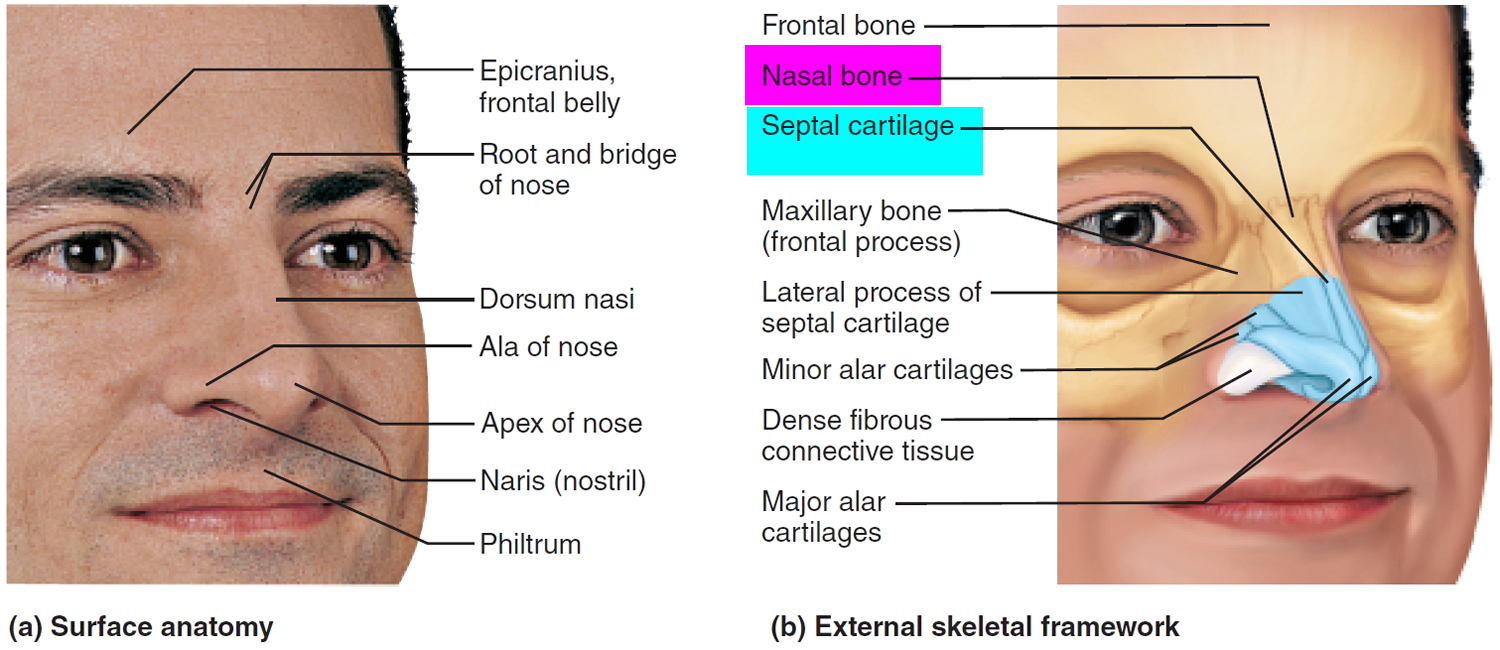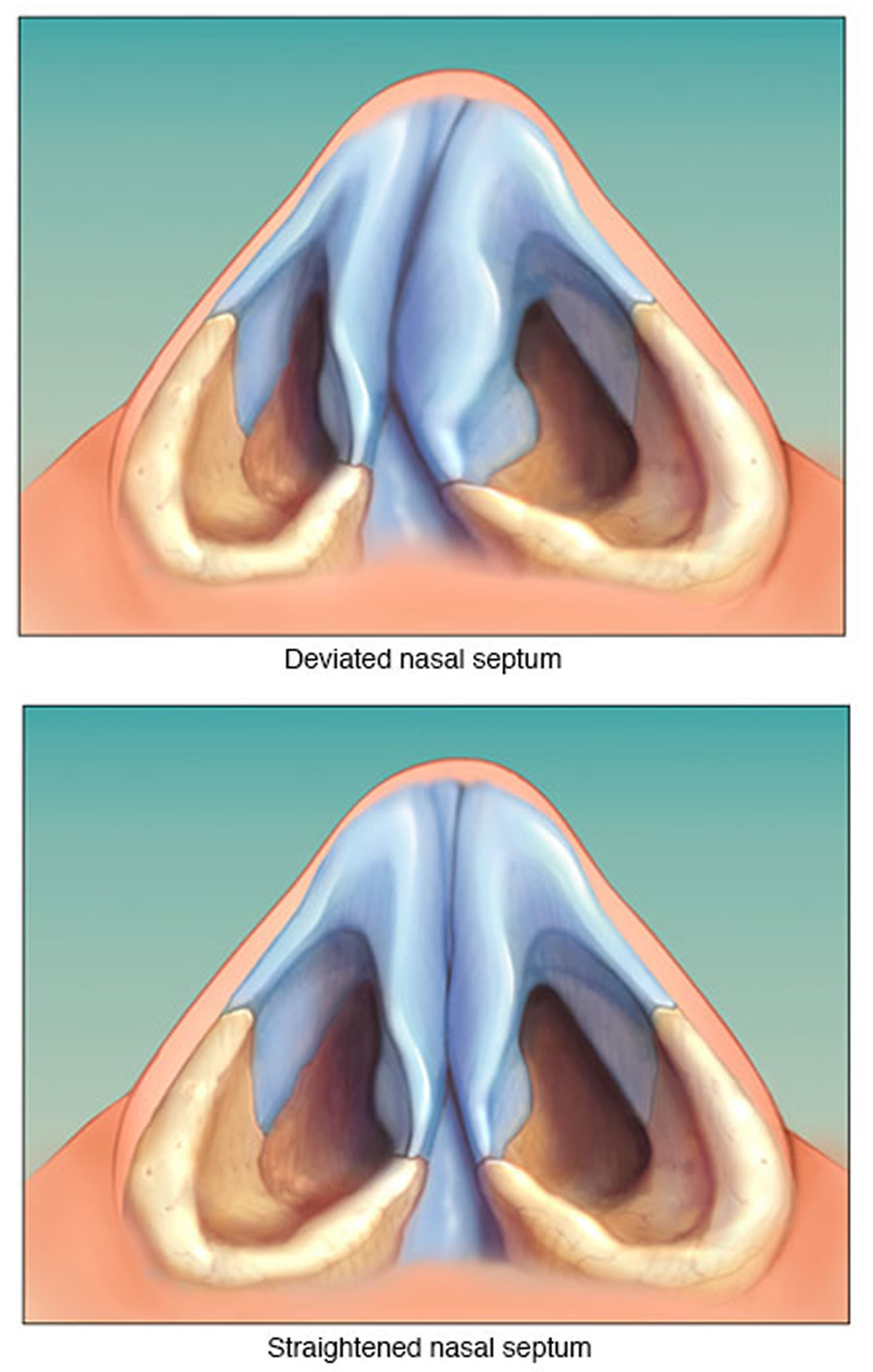Contents
What is a deviated septum
A deviated septum occurs when the nasal septum is severely shifted away from the midline. The most common symptom from a badly deviated or crooked nasal septum is difficulty breathing through the nose. Deviated septum commonly occur due to nasal trauma.The symptoms of deviated septum are usually worse on one side, and sometimes actually occur on the side opposite the bend. In some cases the deviated septum can interfere with the drainage of the sinuses, resulting in repeated sinus infections (chronic sinusitis).
The nasal septum is made of cartilage and bone (see Figure 1 to 4 below). The nasal septum is the wall dividing the nasal cavity into halves (left and right sides); it is composed of a central supporting skeleton covered on each side by mucous membrane. The front portion of this natural partition is a firm but bendable structure made mostly of cartilage and is covered by skin that has a substantial supply of blood vessels. The ideal nasal septum is exactly midline, separating the left and right sides of the nose into passageways of equal size. The cartilage and bone of the nasal septum are lined by a thin membrane called mucosa. This layer acts like a layer of skin for the inside of the nose. This layer covers and protects the cartilage and bone. It also helps to keep the inside of the nose moist.
When the nasal septum is deviated, one or both sides of the nose can become blocked. Nasal obstruction is a fairly common problem. Patients with nasal obstruction have trouble breathing through their nose. This can force them to breathe through their mouth, leading to a sensation of a dry mouth. In many patients, these symptoms get worse at night when they are lying flat. This can cause them to have less restful sleep. In these instances, surgery can help correct the deviation and improve airflow.
The CT scan and picture of the nose shown below in Figure 5 show examples of a deviated nasal septum. Both of these images point to a deviated nasal septum on the left side of the nose.
Estimates are that 80 percent of all nasal septums are off-center, a condition that is generally not noticed. A “deviated septum” occurs when the septum is severely shifted away from the midline. The most common symptom from a badly deviated or crooked septum is difficulty breathing through the nose. The symptoms are usually worse on one side, and sometimes actually occur on the side opposite the bend. In some cases the crooked septum can interfere with the drainage of the sinuses, resulting in repeated sinus infections.
Patients with chronic sinusitis often have nasal congestion, and many have nasal septal deviations. However, for those with this debilitating condition, there may be additional reasons for the nasal airway obstruction. The problem may result from a septal deviation, reactive edema (swelling) from the infected areas, allergic problems, mucosal hypertrophy (increase in size), other anatomic abnormalities, or combinations thereof. A trained specialist in diagnosing and treating ear, nose, and throat disorders can determine the cause of your chronic sinusitis and nasal obstruction.
Septoplasty is the preferred surgical treatment to correct a deviated septum. This procedure is not generally performed on children, because the cartilaginous septum grows until around age 18.
How to tell if you have a deviated septum?
Most septal deformities result in no symptoms, and you may not even know you have a deviated septum.
The most common symptom from a badly deviated or crooked septum is difficulty breathing through the nose. The symptoms are usually worse on one side, and sometimes actually occur on the side opposite the bend. The additional exposure of a deviated septum to the drying effect of airflow through the nose may sometimes contribute to crusting or bleeding in certain individuals.
In some cases the crooked septum can interfere with the drainage of the sinuses, resulting in repeated sinus infections.
- Obstruction of one or both nostrils. This obstruction can make it difficult to breathe through the nostril or nostrils. This may be more noticeable when you have a cold (upper respiratory tract infection) or allergies that can cause your nasal passages to swell and narrow.
- Nosebleeds. The surface of your nasal septum may become dry, increasing your risk of nosebleeds.
- Facial pain. Though there is some debate about the possible nasal causes of facial pain, a severe deviated septum that impacts the inside nasal wall, when on the same side as one-sided facial pain, is sometimes considered a possible cause.
- Noisy breathing during sleep. This can occur in infants and young children with a deviated septum or with swelling of the intranasal tissues.
- Awareness of the nasal cycle. It is normal for the nose to alternate being obstructed on one side, then changing to being obstructed on the other. This is called the nasal cycle. The nasal cycle is a normal phenomenon, but being aware of the nasal cycle is unusual and can be an indication that there is an abnormal amount of nasal obstruction.
- Preference for sleeping on a particular side. Some people may prefer to sleep on a particular side in order to optimize breathing through the nose at night. This can be due to a deviated septum that narrows one nasal passage.
The nose
• Provides an airway for respiration.
• Moistens and warms entering air.
• Filters inhaled air to cleanse it of foreign particles.
The paired nasal bones are small, flattened, rectangular-shaped bones that form the bridge of the nose (see Figures 1 and 2). These small bones protect the upper entry to the nasal cavity and provide attachment for a couple of thin muscles of facial expression. For those of you who wear glasses, they are the bones that form the resting place for the bridge of the glasses. The major structural portion of the nose consists of cartilage (see Figures 3 and 4).
The vomer is a roughly triangular bone on the floor of the nasal cavity that articulates superiorly with the perpendicular plate of the ethmoid bone and sphenoid bone and inferiorly with both the maxillae and palatine bones along the midline (see Figure3). It forms the inferior portion of the bony nasal septum, the partition that divides the nasal cavity into right and left sides.
Figure 1. Nasal bones
Figure 2. Nasal bones
What does a deviated septum look like?
Figure 5. Deviated septum – your nasal septum is significantly displaced to one side, making one nasal air passage smaller than the other
Figure 6. Deviated septum
Deviated septum causes
What causes a deviated septum
A deviated septum occurs when your nasal septum — the thin wall that separates your right and left nasal passages — is displaced to one side.
A deviated septum can be caused by:
- A condition present at birth. In some cases, a deviated septum occurs during fetal development and is apparent at birth.
- Injury to the nose. A deviated septum can also be the result of an injury that causes the nasal septum to be moved out of position. In infants, such an injury may occur during childbirth. In children and adults, a wide array of accidents may lead to a nose injury and deviated septum — from tripping on a step to colliding with another person on the sidewalk. Trauma to the nose most commonly occurs during contact sports, active play or roughhousing, or automobile accidents.
The normal aging process may affect nasal structures, worsening a deviated septum over time. Also, changes in the amount of swelling of nasal tissues, because of developing rhinitis or rhinosinusitis, can accentuate the narrowing of a nasal passage from a deviated septum, resulting in nasal obstruction.
Risk factors for deviated septum
For some people, a deviated septum is present at birth — occurring during fetal development or due to injury during childbirth. After birth, a deviated septum is most commonly caused by an injury that moves your nasal septum out of place. Risk factors include:
- Playing contact sports
- Not wearing your seat belt while riding in a motorized vehicle.
Deviated septum prevention
You may be able to prevent the injuries to your nose that can cause a deviated septum with these precautions:
- Wear a helmet or a midface mask when playing contact sports, such as football and volleyball.
- Wear a seat belt when riding in a motorized vehicle.
Deviated septum complications
If you have a severely deviated septum causing nasal obstruction, it can lead to:
- Dry mouth, due to chronic mouth breathing
- A feeling of pressure or congestion in your nasal passages
- Disturbed sleep, due to the unpleasantness of not being able to breathe comfortably through the nose at night
Deviated septum signs and symptoms
Most septal deformities result in no symptoms, and you may not even know you have a deviated septum.
Some deviated septum deformities, however, may cause the following signs and symptoms:
- Blockage of one or both nostrils. This obstruction can make it difficult to breathe through the nostril or nostrils. This may be more noticeable when you have a cold (upper respiratory tract infection) or allergies that can cause your nasal passages to swell and narrow.
- Nasal congestion, sometimes one-sided
- Frequent nosebleeds. The surface of your nasal septum may become dry, increasing your risk of nosebleeds.
- Frequent sinus infections
- At times, facial pain, headaches, postnasal drip. Though there is some debate about the possible nasal causes of facial pain, a severe deviated septum that impacts the inside nasal wall, when on the same side as one-sided facial pain, is sometimes considered a possible cause.
- Noisy breathing during sleep (in infants and young children). This can occur in infants and young children with a deviated septum or with swelling of the intranasal tissues.
- Awareness of the nasal cycle. It is normal for the nose to alternate being obstructed on one side, then changing to being obstructed on the other. This is called the nasal cycle. The nasal cycle is a normal phenomenon, but being aware of the nasal cycle is unusual and can be an indication that there is an abnormal amount of nasal obstruction.
- Preference for sleeping on a particular side. Some people may prefer to sleep on a particular side in order to optimize breathing through the nose at night. This can be due to a deviated septum that narrows one nasal passage.
In some cases, a person with a mildly deviated septum has symptoms only when he or she also has a “cold” (an upper respiratory tract infection). In these individuals, the respiratory infection triggers nasal inflammation that temporarily amplifies any mild airflow problems related to the deviated septum. Once the “cold” resolves, and the nasal inflammation subsides, symptoms of a deviated septum often resolve, too.
Deviated septum diagnosis
The diagnosis of a deviated septum can be made by your doctor.
After discussing your symptoms, your primary care physician or otolaryngologist (ear, nose and throat specialist) will inquire if you have ever incurred severe trauma to your nose and if you have had previous nasal surgery. Next, an examination of the general appearance of your nose will occur, including the position of your nasal septum. You may undergo a procedure in the office called a nasal endoscopy to diagnose the cause of your nasal obstruction. This will entail the use of a bright light and a nasal speculum (an instrument that gently spreads open your nostril) to inspect the inside surface of each nostril.
A deviated septum can also be seen on a CT scan, but a scan is often not necessary to diagnose the cause of nasal obstruction. Additional testing may be required in some circumstances.
After making the diagnosis, your doctor can discuss treatment options for you. If you have troublesome symptoms, you may be a candidate for surgery to straighten your septum. For example, surgery may be the recommended treatment if the deviated septum is causing troublesome nosebleeds or recurrent sinus infections.
Deviated septum treatment
How to fix a deviated septum
Initial treatment of a deviated septum may be directed at managing the symptoms of the tissues lining the nose, which may then contribute to symptoms of nasal obstruction and drainage. Your doctor may prescribe:
- Decongestants. Decongestants are medications that reduce nasal tissue swelling, helping to keep the airways on both sides of your nose open. Decongestants are available as a pill or as a nasal spray. Use nasal sprays with caution, however. Frequent and continued use can create dependency and cause symptoms to be worse (rebound) after you stop using them. Decongestants have a stimulant effect and may cause you to be jittery as well as elevate your blood pressure and heart rate.
- Antihistamines. Antihistamines are medications that help prevent allergy symptoms, including obstruction and runny nose. They can also sometimes help nonallergic conditions such as those occurring with a cold. Some antihistamines cause drowsiness and can affect your ability to perform tasks that require physical coordination, such as driving.
- Nasal steroid sprays. Prescription nasal corticosteroid sprays can reduce inflammation in your nasal passage and help with obstruction or drainage. It usually takes from one to three weeks for steroid sprays to reach their maximal effect, so it is important to follow your doctor’s directions in using them.
Medications only treat the swollen mucus membranes and won’t correct a deviated septum.
Deviated septum surgery
If you still experience symptoms despite medical therapy, you may consider surgery to correct your deviated septum.
Surgery to correct a deviated septum is called a septoplasty. Septoplasty is most commonly performed to help relieve nasal obstruction. Sometimes, septoplasty is a necessary part of other surgical procedures like sinus surgery or nasal tumor removal.
Septoplasty is a surgical procedure performed entirely through the nostrils, accordingly, no bruising or external signs occur. The deviated septum surgery might be combined with a rhinoplasty, in which case the external appearance of the nose is altered and swelling/bruising of the face is evident. Septoplasty may also be combined with sinus surgery.
During a septoplasty, your surgeon will attempt to straighten the cartilage and bone that have led to the septum being deviated. During the procedure, the lining (the mucosa) is first lifted off the cartilage and bone. The cartilage and bone can then be reshaped. During the surgery sometimes portions of the badly deviated septum may be removed entirely or they may be readjusted and reinserted into the nose and bone need to be removed. The lining is then laid back down.
The time required for the deviated septum surgery averages about one to one and a half hours, depending on the deviation. Deviated septum surgery is a procedure that is done in the operating room under anesthesia. The procedure is typically performed under general anesthesia, but your doctor can help you decide if local anesthesia is an option for you. The procedure is typically performed on an outpatient basis. This means that patients come in and go home the same day.
If a deviated nasal septum is the sole cause for your chronic sinusitis, relief from this severe disorder will be achieved. Because the septal cartilage has ‘memory’–it has a tendency to assume its initial shape– the septal cartilage can sometimes bend after the deviated septum surgery.
After the surgery, nasal packing is inserted to prevent excessive postoperative bleeding. You may have splints or packing inside your nose during the healing process. In some instances, there may be nothing more than dissolving stitches inside your nose. Your surgeon can let you know whether packing or splints will be placed in your nose and how long they will stay in place.
Reshaping your nose
In some cases, surgery to reshape the nose (rhinoplasty) is performed at the same time as septoplasty. Rhinoplasty involves modifying the bone and cartilage of your nose to change its shape or size or both.
Figure 7. Rhinoplasty
Deviated septum surgery recovery
You can expect to have pain, fatigue, nasal stuffiness, and mild nasal drainage after your surgery. Pain is generally mild with this type of surgery and is typically well controlled with oral pain medications. The stuffiness typically results from swelling after the procedure, and typically generally starts to improve after the first week. You may have drainage of some mucus and blood from your nose after surgery. This is a normal part of the healing process.
You may be asked to use saline sprays or irrigations after your surgery. Please check with your surgeon about any post-operative care you will need to perform to allow your nose to heal properly.












